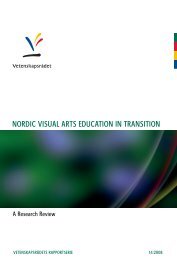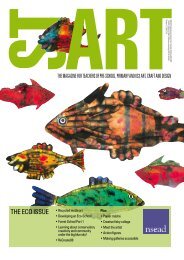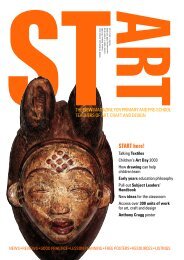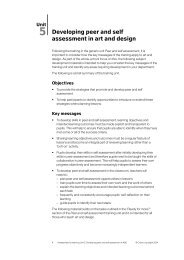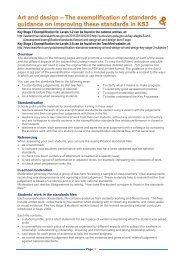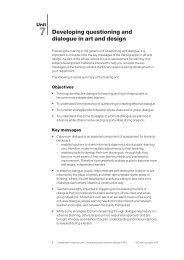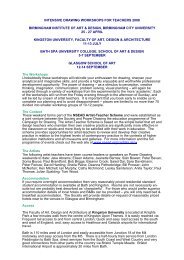textiles issue - The National Society for Education in Art and Design
textiles issue - The National Society for Education in Art and Design
textiles issue - The National Society for Education in Art and Design
You also want an ePaper? Increase the reach of your titles
YUMPU automatically turns print PDFs into web optimized ePapers that Google loves.
H<strong>and</strong>s-on <strong>in</strong> the classroomVisitwww.gamthi.comH<strong>and</strong>s-on <strong>in</strong> the classroomIndian<strong>in</strong>spirationNaomi Renouf, textile artist <strong>and</strong> art <strong>and</strong>design coord<strong>in</strong>ator at St Lawrence PrimarySchool <strong>in</strong> Jersey, shows how Indian<strong>textiles</strong> can <strong>in</strong>spire textile <strong>and</strong> mixedmediaart projects <strong>for</strong> Key Stage 2.India is a topic studied annually <strong>in</strong> Year 5 atSt Lawrence School <strong>and</strong> art always has ahigh profile. This has led to a variety ofrelated art projects, most of which <strong>in</strong>volve<strong>textiles</strong> <strong>in</strong> some way, be<strong>in</strong>g developedover a number of years.Background: Gujarati patchworkwall-hang<strong>in</strong>gsGujarati wall-hang<strong>in</strong>gs are colourful <strong>and</strong>highly decorative. <strong>The</strong>y are made ofsections of cloth<strong>in</strong>g that has been worn <strong>for</strong>special events such as wedd<strong>in</strong>gs, religiousceremonies <strong>and</strong> festivals. <strong>The</strong>se may befamily heirlooms, passed down fromgeneration to generation until they areeventually replaced by newer garments.Sections of these garment are then‘recycled’ to make patches <strong>in</strong> beautiful wallhang<strong>in</strong>gs. <strong>The</strong>se wall hang<strong>in</strong>gs can beused <strong>in</strong> school as a stimulus <strong>for</strong> children toproduce their own <strong>in</strong>terest<strong>in</strong>g texturedwork us<strong>in</strong>g a variety of media.Mixed-media texturedpicturesLearn<strong>in</strong>g objectives• to consider pattern, colour <strong>and</strong>composition <strong>in</strong> decorative Indian <strong>textiles</strong>• to create pattern <strong>and</strong> texture us<strong>in</strong>g avariety of mediaPreparationShow the children a suitable hang<strong>in</strong>g. <strong>The</strong>seare widely available <strong>in</strong> markets <strong>and</strong> shops <strong>in</strong>the UK <strong>and</strong> on the <strong>in</strong>ternet. Look carefully atthe construction <strong>and</strong> the layout, <strong>and</strong> at thepatterns made by the embroidery, beads,sequ<strong>in</strong>s <strong>and</strong> mirrors. <strong>The</strong> children can drawsome of these patterns <strong>in</strong> their sketchbooks<strong>in</strong> preparation <strong>for</strong> work<strong>in</strong>g on their f<strong>in</strong>ishedpieces.Pa<strong>in</strong>t<strong>in</strong>g the paperGive the children pre-cut paper <strong>and</strong> askthem to divide it up <strong>in</strong> a similar way to thewall hang<strong>in</strong>g, us<strong>in</strong>g a pencil. Once theyhave done this they can pa<strong>in</strong>t each areawith acrylic pa<strong>in</strong>t. Let them choose <strong>and</strong>mix their colours, <strong>and</strong> encourage variety –they don’t need to be the same as thehang<strong>in</strong>g. Once the paper is completelycovered, leave it to dry.Decorat<strong>in</strong>g the surfacePattern <strong>and</strong> texture can be created <strong>in</strong> anumber of ways, but it is a good idea tooutl<strong>in</strong>e the pa<strong>in</strong>ted patches of colour first.This can be done with 3D pa<strong>in</strong>t or pa<strong>in</strong>tmixed with PVA glue <strong>in</strong> a plastic bottlewith a nozzle (it gives a thicker l<strong>in</strong>e than 3Dpa<strong>in</strong>t but is much cheaper). It can also bedone with str<strong>in</strong>g or similar thread, or evenwith a l<strong>in</strong>e of glue with coloured s<strong>and</strong>spr<strong>in</strong>kled on it. Patterns can then be builtup with<strong>in</strong> the coloured areas <strong>in</strong> the sameway. Pipe cleaners can be twisted <strong>in</strong>tosuitable shapes <strong>and</strong> stuck on (don’t usethe brightly coloured chenille ones as theyare very difficult to stick on). <strong>The</strong>y can bepa<strong>in</strong>ted with metallic pa<strong>in</strong>t afterwards.Beads, sequ<strong>in</strong>s, buttons, pieces of lace,<strong>textiles</strong> <strong>and</strong> threads can all be used tobuild up the surface <strong>and</strong> create someth<strong>in</strong>grichly patterned <strong>and</strong> <strong>in</strong>terest<strong>in</strong>g.Resourcescartridge paper (calico could also beused), acrylic pa<strong>in</strong>t, PVA glue, 3D fabricpa<strong>in</strong>t, str<strong>in</strong>g, s<strong>and</strong>, <strong>textiles</strong>, pipe-cleaners,metallic pa<strong>in</strong>ts, plastic applicator bottles,e.g. washed out hair-dye bottles (<strong>for</strong>thicker l<strong>in</strong>es), beads, buttons, sequ<strong>in</strong>s<strong>and</strong> other suitable bits <strong>and</strong> piecesBead <strong>and</strong> sequ<strong>in</strong> workFor this next activity, you can use a Gujaratihang<strong>in</strong>g, embroidered sari fabric or otherexamples of Indian <strong>textiles</strong>. Other shapescould be used, but the motif that we nowcall paisley is particularly suitable. Thisshape was orig<strong>in</strong>ally a representation ofthe teardropped-shaped leaf of the Chenartree <strong>and</strong> was found on Kashmiri shawls.Learn<strong>in</strong>g objectives• to look at pattern <strong>and</strong> shape• to stitch objects on to a surface• to look at typical pattern<strong>in</strong>g <strong>in</strong> Indian<strong>textiles</strong>• to create an <strong>in</strong>dividual <strong>in</strong>terpretation ofpart of a patternWhat to doShow the children examples of Indian<strong>textiles</strong> with suitable patterns <strong>and</strong>beadwork. Get each child to draw a simpleoutl<strong>in</strong>e shape on their piece of fabric. Alength of thick decorative thread can thenbe couched <strong>in</strong> place on top of this outl<strong>in</strong>eshape by stitch<strong>in</strong>g over the top of thethread at <strong>in</strong>tervals along its length. Beads<strong>and</strong> sequ<strong>in</strong>s can then be arranged <strong>and</strong>stitched around it. To keep sequ<strong>in</strong>s <strong>in</strong>place, stitch up through the fabric <strong>and</strong>sequ<strong>in</strong>, then stitch though a small bead<strong>and</strong> back though the sequ<strong>in</strong> <strong>and</strong> fabric.If you don’t want to sew, you can do thesame activity us<strong>in</strong>g 3D fabric pa<strong>in</strong>ts. Whilethe pa<strong>in</strong>t is still wet, you can place beads<strong>and</strong> sequ<strong>in</strong>s <strong>in</strong> the pa<strong>in</strong>t <strong>and</strong> they willrema<strong>in</strong> <strong>in</strong> place when it dries, or they canbe attached afterwards us<strong>in</strong>g PVA glue.ResourcesSmall pieces of coloured cotton, thread,needles, needle-threaders, beads,sequ<strong>in</strong>s, thick decorative threadsBlock-pr<strong>in</strong>ted fabrics<strong>The</strong> art of mak<strong>in</strong>g Indian block-pr<strong>in</strong>t <strong>textiles</strong>has survived from ancient times to thepresent. <strong>The</strong> three ma<strong>in</strong> tools used <strong>in</strong> thisprocess are the wooden blocks, the fabric<strong>and</strong> the dye. It takes carvers days to createan <strong>in</strong>tricate design <strong>in</strong> a block of teak <strong>for</strong> useas a pr<strong>in</strong>t<strong>in</strong>g block, but blocks are availableto buy <strong>and</strong> are great <strong>for</strong> us<strong>in</strong>g <strong>in</strong> school. Ifyou want to create your own, l<strong>in</strong>o-cutt<strong>in</strong>g isa good alternative.Some good examples of Indianblock-pr<strong>in</strong>ted fabric can be seen atwww.gamthi.com.START THE MAGAZINE FOR PRIMARY AND PRE-SCHOOL TEACHERS OF ART, CRAFT AND DESIGNSTART THE MAGAZINE FOR PRIMARY AND PRE-SCHOOL TEACHERS OF ART, CRAFT AND DESIGN




